2023 年 40 巻 p. 186-196
2023 年 40 巻 p. 186-196
The United Nations Sustainable Development Goals (SDGs) have attracted much attention due to increasing interest in global social, energy and environmental problems. The immediate contribution to the achievement of the SDGs is required in all individual and industrial activities. The industries dealing with fine particles are also no exception to the demand and have actively worked on the contribution. Conventionally, fine particles have been industrially synthesized in gas, liquid and solid phases using top-down and bottom-up approaches. Among them, dry synthesis processes are promising from a viewpoint of the SDGs due to the solvent-free and simplicity, which can lead to energy saving, efficient resource utilization, waste management, etc. This review describes dry mechanical processes for synthesis of fine particles, particularly focusing on grinding and mechanochemical treatment.
The United Nations Sustainable Development Goals (SDGs) consisting of 17 goals with 169 targets require to solve serious global problems relating to, for example, health, education, safety and human rights as well as resource, energy and environment. The SDGs have been widely spread through various media and many people recognize the importance. At present, contributions to the achievement of the SDGs cannot be avoided in all human activities ranging from individual to global level. In particular, business activities considering the SDGs are becoming more active according to corporate image-building (branding) strategy which can affect the sales of products due to high consumer recognition. Under such circumstances, we frequently see and hear the SDGs everywhere.
1.2 SDGs in powder processingPowder handling and processing, such as storage, conveying, mixing, reaction, crystallization, grinding, compaction, granulation, classification, separation, and surface modification, are also required to work diligently on the contribution to the achievement of the SDGs without exception. To do so, conventional powder processes may be modified to eco- and environment-friendly (green) processes by applying various advanced technologies (Fig. 1). Examples of possible future contribution of powder processes are listed in Table 1. In Fig. 1 and Table 1, 9 goals which are expected to be achieved in the near future are selected as an example. Some powder processes and products considering the SDGs have been reviewed: e.g., food (Bartolucci et al., 2020), pharmaceutical (Assali and Zaid, 2022), agricultural material (Swoboda et al., 2022), catalyst (Nawaz et al., 2021), antibacterial material (Bhardwaj et al., 2021; Parmar et al., 2022), environmental improvement material (Nnadozie and Ajibade, 2020; Rehman et al., 2021). The use of fine particles in the processes shows many merits such as uniformity and reactivity; however, some serious demerits such as safety, labor environment and air pollution are latent. Although attempts for removing the demerits have been conducted, there are still few cases emphasizing clearly the contribution to the achievement of the SDGs; the technology development in this field seems to fall behind. Therefore, various improvements can be made in the powder processes. In particular, energy saving and/or process simplifying should be immediately realized in all processes, which can lead to the reduction of process costs and environmental impacts.
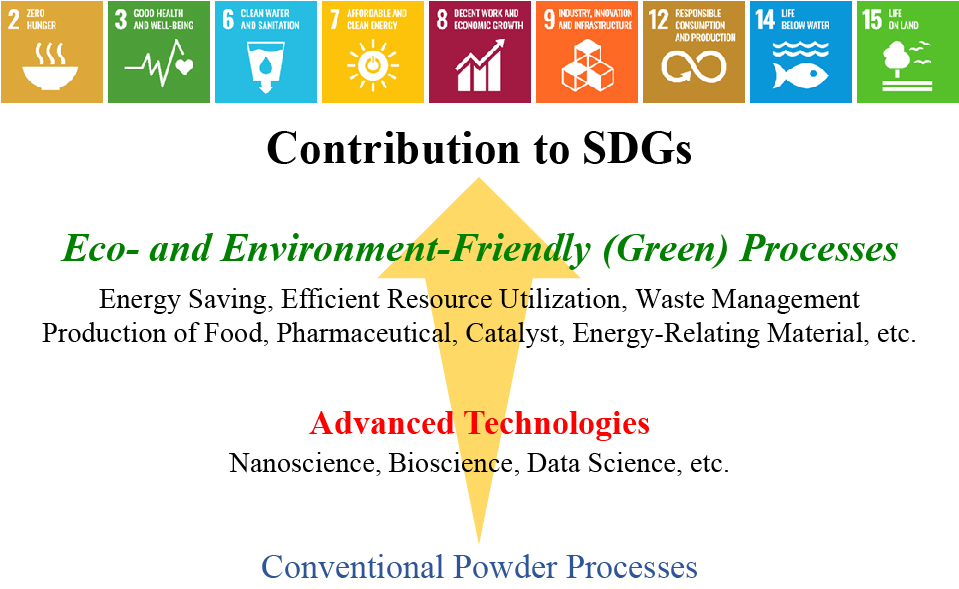
Contribution of powder processes to SDGs.
Examples of possible future contribution of powder processes.
| Goal (Target) | Example |
|---|---|
| 2 (2.1, 2.4, 2.c) |
Improvement of productivity, processability and functionality of foods |
| Stabilization of foods for long-term storage | |
| Development of functional fertilizers with high performance | |
| 3 (3.8, 3.9) |
Development of functional pharmaceuticals with high performance |
| Improvement of productivity and stability of pharmaceuticals | |
| Environmental purification | |
| 6 (6.3, 6.a) |
Purification and conservation of water environment |
| Treatment of waste and polluted water | |
| Recycling and reuse of water | |
| 7 (7.2, 7.3, 7.a) |
Generation of clean energy (hydrogen production) |
| Energy saving | |
| 8 (8.3) |
Improvement working environment |
| Reduction of working hours | |
| 9 (9.4, 9.5, 9.b) |
Effective use of resources |
| Innovation in powder processing technologies | |
| Development of processes for synthesis of functional particles | |
| 12 (12.2, 12.4, 12.5) |
Effective use of fossil fuels by energy saving |
| Reduction and utilization of wastes | |
| 14 (14.1, 14.3) |
Removal of marine pollutants |
| Improvement of ocean acidification by immobilization of atmospheric CO2 | |
| 15 (15.3) |
Restraint of expansion of cultivated acreage by improvement of food production efficiency |
In general, fine particles can be synthesized by various wet and dry processes using bottom-up (build up) and top-down (break down) approaches. In bottom-up methods, monomers form via assembly of atoms and molecules and then particles are obtained by growing them. The formation process is described by the LaMer diagram. The particle synthesis processes are operated in gas, liquid and solid phases, and the particle formation progresses according to almost the same mechanism regardless of the type of phases. However, the growth rate of particles greatly varies in the phases depending strongly on the diffusion velocity of atoms and molecules. When the growth rate is higher, the productivity of particles also becomes larger; in contrast, the control of particle size distribution is difficult.
Usually, the bottom-up processes using gas (Kerminen et al., 2018; Khitab et al., 2018) and liquid (Jadoun et al., 2021; Khitab et al., 2018; Mastalska-Popławska et al., 2020; Shaikh et al., 2021; Wichaita et al., 2019) phases are employed. However, liquid-phase methods have some weak points: e.g., additional post-treatments, such as solid-liquid separation, liquid waste treatment, drying and disintegration of aggregates, which leads to the increase in the energy consumption and process cost. Accordingly, gas-phase methods without any post liquid treatments, such as physical vapor deposition (PVD) and chemical vapor deposition (CVD) with heating by chemical flame, plasma, laser and high frequency induction, may be slightly advantageous, although they are low versatility and need high temperatures. In any case, bottom-up processes seem to be unsuitable to the contribution to meeting the SDGs. However, as technologies of measurement and analysis progress, dry mechanochemical processes using solid-state reactions have been recognized as a useful bottom-up method.
1.3.2 Top-down approachOn the other hand, in top-down methods, the raw feed is broken (ground) into small pieces by applying the mechanical energy. Powder grinding has been traditionally used in home and industries due to the simple operation. Although technical problems in grinding, such as the mechanical work (energy) for obtaining fine particles with a desired size, the prediction and control of the size distribution of products, and the analysis of grinding kinetics, have been studied, they are still not completely solved. For contributing to the SDGs, such problems must be solved by using new technologies (e.g., machine learning).
The grinding processes are classified roughly into dry and wet methods and various types of machines are used for dry and wet grinding. The particle formation mechanism is complicated regardless of the methods because the particle breaking is caused by various kinds of loads induced by compression, tension, shear, bending, friction, and so on. However, the grinding processes have some merits which can lead to the contribution to meeting the SDGs: e.g., simple process, high throughput, low cost, etc. The particle breaking occurs according to two mechanisms: volume grinding and surface grinding. For producing fine particles, the latter is effective. In dry grinding processes, newly formed fine particles tend to aggregate each other during grinding. When the particle size reaches a few micrometers, the grinding can often be in an apparent equilibrium state. Further size reduction often requires wet grinding, which can provide nanometer-sized particles. For the production of dry powder, however, dry grinding processes do not need additional post-treatments, such as solid-liquid separation and drying, and are conventionally recognized as a green process with low environmental impact. Therefore, dry grinding is contributable to the achievement of the SDGs (Fig. 2).

Overview of connections between dry processing and SDGs.
For bulk synthesis of fine particles under dry conditions, not only dry grinding as a top-down method but also dry mechanochemical process as a bottom-up method are an effective choice. In both cases, the improvement of energy consumption and productivity is a very important problem and the efficiencies must be sufficiently increased. In addition, the functionalization and/or enhancement of properties should be made through the processes. These progress may contribute to many SDGs.
There are still few papers describing dry particle synthesis with an emphasis on the contribution to meeting the SDGs. This article reviews recent studies on dry mechanical processing for particle formation, which pay attention to SGDs and are published mainly in the last decade. In particular, dry grinding and mechanochemical processes are focused.
Grinding (including comminution and pulverization) of particulate materials under dry conditions have been conventionally used in many industrial fields for various purposes such as enhancement of the reactivity due to increase in the specific surface area and improvement of the processability and handling. Conventional dry grinding processes with older technologies can often consume large energy and cause the reduction of the productivity and the discharge of large amounts of waste. Technological innovation in the dry grinding can solve the serious problems. Therefore, recent dry grinding processes substantially contribute to meeting SDGs, in particular, waste management. Soni et al. (2022) mentioned a role of grinding process in solid waste management for effective utilization of mineral resources waste as building construction materials in India.
Many researchers have also devoted to the reduction of energy consumption in the grinding processes. For increasing the energy efficiency leading to achievement of SDGs 7, 9, 12 and 13, García et al. (2021) analyzed in detail the results of the Bond grindability test to elucidate the influence of particle size distribution of feed and ground products on the Bond work index using an experimental design approach. As a result, the mesh size of a sieve used to close the grinding circuit and the 80 % passing size of feed were found to be the important parameters via the ANOVA test. As a contribution to SDGs relating to food problems, Raheem et al. (2022) refer to the grinding of corn, which is one of the most important crops in the world and is used for not only human food and animal feed but also bioethanol production, for the added value enhancement.
2.2 Possible contribution of dry grinding to SDGsDry grinding processes have also been employed traditionally in mining industries (e.g., beneficiation). Recently, for example, Chelgani et al. (2019) investigated the grinding effects on the energy consumption in the mineral flotation separation. They found that the dry grinding mechanically activated the particle surfaces and increased the floatability, which can reduce the energy consumption during flotation separation. In various food industries, dry grinding processes have been widely used, and some review articles relating to SDGs have been published: e.g., superfine grinding (Gao et al., 2020), fruit and vegetable powders (Karam et al., 2016), moisture content effect (Jung et al., 2018). It is expected that technological progress on dry grinding in food industrial fields can contribute directly to meeting Goal 2: Zero Hunger.
For the achievement of SDGs, the improvement of energy consumption in the dry grinding processes is significantly important. Many researches relating to the analysis of energy consumption discuss the energy efficiency using the specific grinding energy and/or electric power consumption (Altun et al., 2015, 2019; Blanc et al., 2020; Katircioglu-Bayel et al., 2020; Ngamnikom and Songsermpong, 2011; Ogonowski et al., 2018; Tamura et al., 2017, 2020). In particular, Prziwara, Kwade and co-workers (Prziwara et al., 2018a; 2018b; 2018c; 2019; 2020a) have actively studied in detail the effects of grinding aids on the grinding efficiency in dry fine grinding processes. They carefully analyzed the obtained results focusing on the energy consumption and the surface energy of particles, and give us useful guidelines for the selection of grinding aids. For example, they used the relative fineness increase, defined as the ratio of the specific surface area of product obtained with a grinding aid to that obtained without any grinding aid, as an index of the progress of grinding (Prziwara and Kwade, 2020b). The fineness increase was correlated with the energy consumption, which expressed quantitatively the difference of the grinding aid effects between amine-based and glycol-based additives. Therefore, their research results can contribute to reduction of the grinding energy consumption.
The work index (Chipakwe et al., 2020) and the impact energy of media calculated using the simulation of the behavior (Burmeister et al., 2018) have sometimes been utilized as the numerical index. Hirosawa and Iwasaki (2021) numerically analyzed the dissipated energy of particle in a planetary mill using the discrete element method (DEM) simulation of the behavior of the particles and balls to study the dependence of effective grinding energy on the conditions and the progress of grinding (i.e., particle size reduction) (Fig. 3). They found that using an appropriate size and number of balls in accordance with the stages of grinding is effective for precisely controlling the dissipated energy of particles even when the particle size decreased as the progress of grinding (Fig. 4). Therefore, the numerical simulation can give us the information relating to optimization of dry grinding processes.
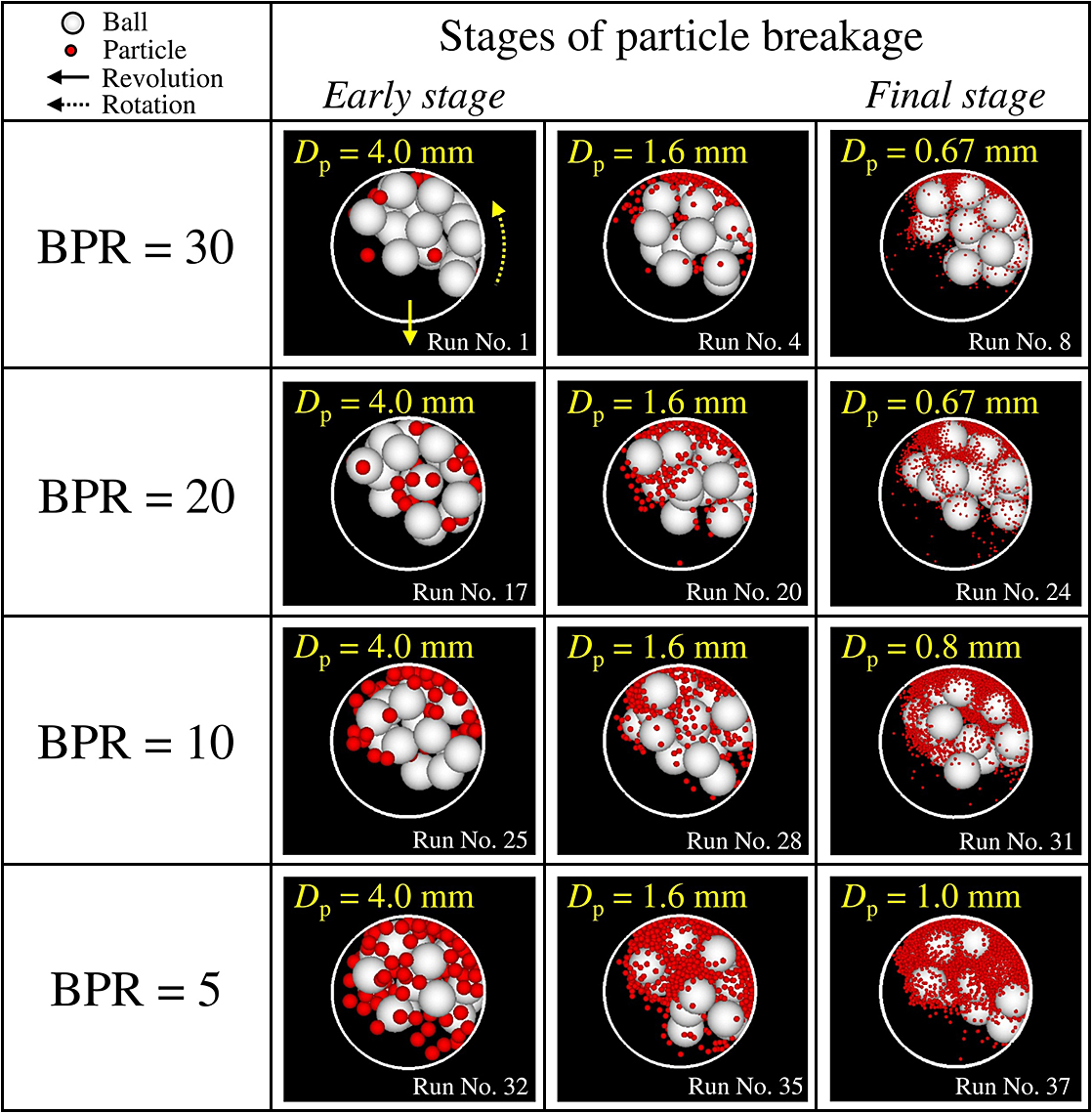
Snapshots of behaviors of particles and balls mimicking various stages of particle breakage at different values of ball-to-particle mass ratio (BPR) (ball diameter = 10 mm). Reprinted with permission from Ref. (Hirosawa and Iwasaki, 2021). Copyright: (2021) Elsevier.

Effect of changing ball diameter and number of balls on variation in specific dissipated energy with particle breakage stage. Reprinted with permission from Ref. (Hirosawa and Iwasaki, 2021). Copyright: (2021) Elsevier.
In addition to above, some unique studies which can potentially contribute to meeting SDGs have been reported: e.g., analysis of grinding processes (Bu et al., 2019; 2020; Krauze et al., 2021; Nava et al., 2020; Prziwara et al., 2020a; Toraman, 2013), characterization and utilization of ground products (Arsoy et al., 2017; Choi et al., 2016; Gomez et al., 2019; Guzzo et al., 2019; 2020; Letelier et al., 2019; Liu et al., 2015; Makuza et al., 2021; Okazaki et al., 2022; Peltoniemi et al., 2020; Yang et al., 2021). However, the grinding mechanism considerably changes depending on the type of grinding machine, which makes it difficult to evaluate the energy efficiency using a unified standard. The standardization of the evaluation method is required for further contributions.
Generally, in dry grinding of particulate materials, the raw feed receives the mechanical energy induced by shear, compression, impact and friction, and then is ground into finer particles. At this moment, new particle surfaces form, of which the structure differs from that of the inside. By applying further the mechanical energy to the particles, the chemical bonding state of atoms microscopically changes (e.g., partial breaking), which can lead to increase in the disturbance of crystal lattice (lattice defect and lattice mismatch). Simultaneously, the plastic deformation energy can be accumulated in the particles. Such unstable state of the particles leads to a chemically activated state, which is so-called mechanical activation. This can result in various physicochemical changes, such as increase in the surface energy of particles, formation of radicals, adhesion and aggregation of particles, solid-phase reaction. In addition, this may cause chemical interaction between the particles and surrounding materials, i.e., mechanochemical reaction (Masuda et al., 2006). Mechanochemical effects are confirmed in many materials such as inorganic and organic materials and metals and can be practically applied to not only material synthesis but also material separation, resource processing and recycling. For example, the mechanochemical synthesis of porous materials was reviewed by Szczęśniak et al. (2020). The mechanical activation has been utilized for the reduction of reaction temperature of biochar (Tayibi et al., 2021) and the stabilization of heavy metals in fly ash for extraction control, i.e., reduction of the metal toxicity (Yuan et al., 2021). Mechanochemical treatments of natural and artificial resources can enable the recovery of valuables under mild conditions and the simultaneous grinding can act effectively as a pretreatment of the subsequent material processing.
3.2 Relationship between dry mechanochemical treatment and SDGsMechanochemical treatments have conventionally been used as an effective and powerful tool mainly for synthesis of materials in anticipation of local high-temperature and high-pressure environments, induced activation of reactants, rapid reaction, etc. In particular, dry (solvent-free) mechanochemical processes have been tried to apply to various inorganic and/or organic systems due to its simplicity and room-temperature operation. Many remarkable results of dry mechanochemical synthesis have been produced so far. Furthermore, a lot of articles reviewing various dry mechanochemical processes have also been published. Recently, Dong et al. (2022) review recent findings and potential applications of mechanochemical processes in the fields of environmental governance and energy storage, such as treatments of toxic compounds and recovery of valuables from energy storage materials. André el al. (2022) introduce the mechanochemical applications growing in Portugal, such as crystalline compounds of pharmaceuticals and bio-inspired metal-organic frameworks, ionic liquids, and liquid crystals. Kumar et al. (2020) present useful scientific knowledge on value-added recycling of biomass wastes through the mechanochemical synthesis of biochar-based materials via various ball milling treatments, which can contribute to the realization of carbon neutral society.
Dry mechanochemical syntheses of functional materials with high performance considering SDGs have been reported in recent years. For example, Danielis et al. (2021) synthesized the methane oxidation catalyst for natural gas fueled vehicles by a dry mechanochemical process using a planetary ball mill. The mechanochemical treatment may result in the formation of the particular structure suitable to high catalytic activity due to promotion of the surface oxygen mobility. The mechanochemically prepared catalyst showed excellent catalytic performance for simultaneous NOx reduction and CH4 oxidation (Fig. 5). Sharma et al. (2022) used a software tool for evaluating greenness of some mechanochemical processes with different milling mechanisms for synthesis of nitrofurantoin from a standpoint of the 12 Principles of Green Chemistry (Anastas and Warner, 1998). They show interesting results that a shaker mill and a twin-screw extrusion exhibit increased energy efficiency, improved resources use, and reduced human and environmental hazards compared to other commercial processes, which was determined based on the evaluation scores (Fig. 6). The difference in scores is mainly due to the difference in time of synthesis and in the product yield. This method may be useful for the development of greener mechanochemical processes.
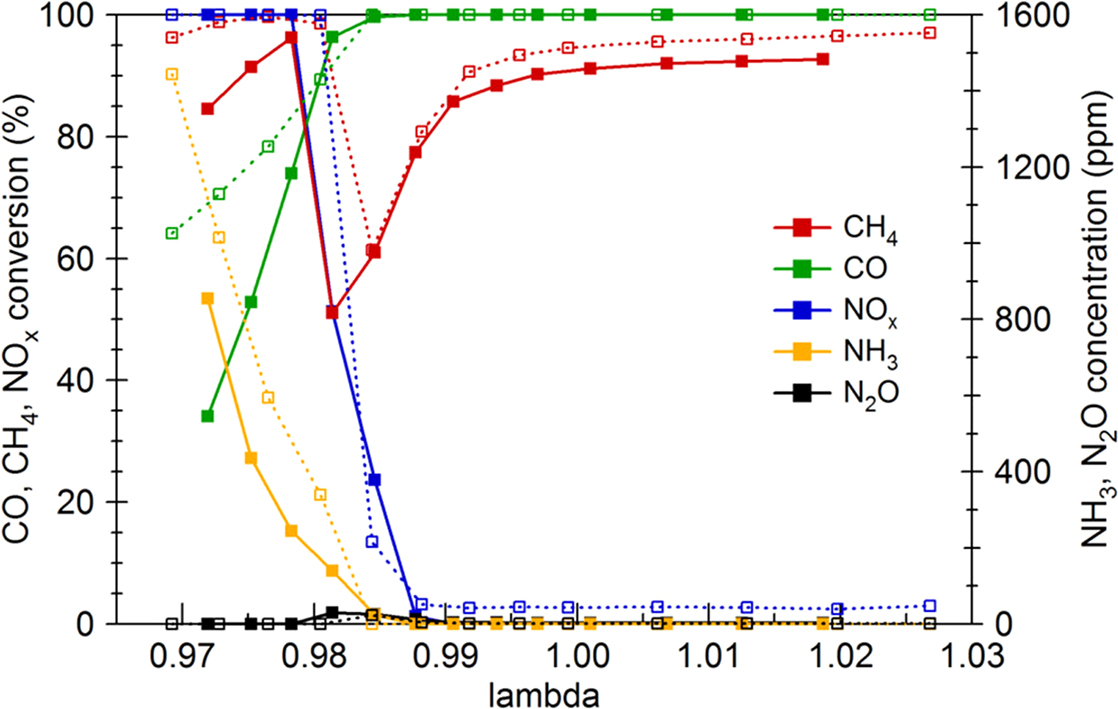
Synthetic reactor results with full gas mixture at 823 K for the 2-modes aged Pd/CeO2 catalyst sample (solid line, full symbols) and the 4-modes aged commercial Pd-based three-way catalyst (dotted line, open symbols). Reprinted with permission from Ref. (Danielis et al., 2021). Copyright: (2021) American Chemical Society.

Comparisons of greenness of batch vs continuous mechanochemical processes for the preparation of nitrofurantoin. Reprinted with permission from Ref. (Sharma et al., 2022). Copyright: (2022) American Chemical Society.
Zhang et al. (2022) developed the mechanochemical solid-state cross-coupling of amides by nitrogen–carbon bond activation (Fig. 7), which is conducted under solventless conditions without external heating for short reaction time. The merit of the method is avoidance of potentially harmful solvents, which can lead to minimizing wastes and reducing environmental impacts. This mechanochemical cross-coupling can be applied to the synthesis of pharmaceutical intermediates (Fig. 8). The contribution of the method to various chemical processes may be quite large. Hirosawa et al. (2019) analyzed the rate of the mechanochemical reaction to form ZnFe2O4 via high-energy ball milling of a mixture of ZnO and γ-Fe2O3 based on the kinetic theories for thermal chemical reactions using experimental and numerical approaches. The reaction rate constant was found to be correlated with the energy factor and frequency factor, similarly to the Arrhenius equation for thermal chemical reactions (Fig. 9). Their method of analyzing the rate of mechanochemical reactions can contribute to not only precise control of the reaction rate but also the effective utilization of energy, the process optimization based on the mechanical energy, etc.
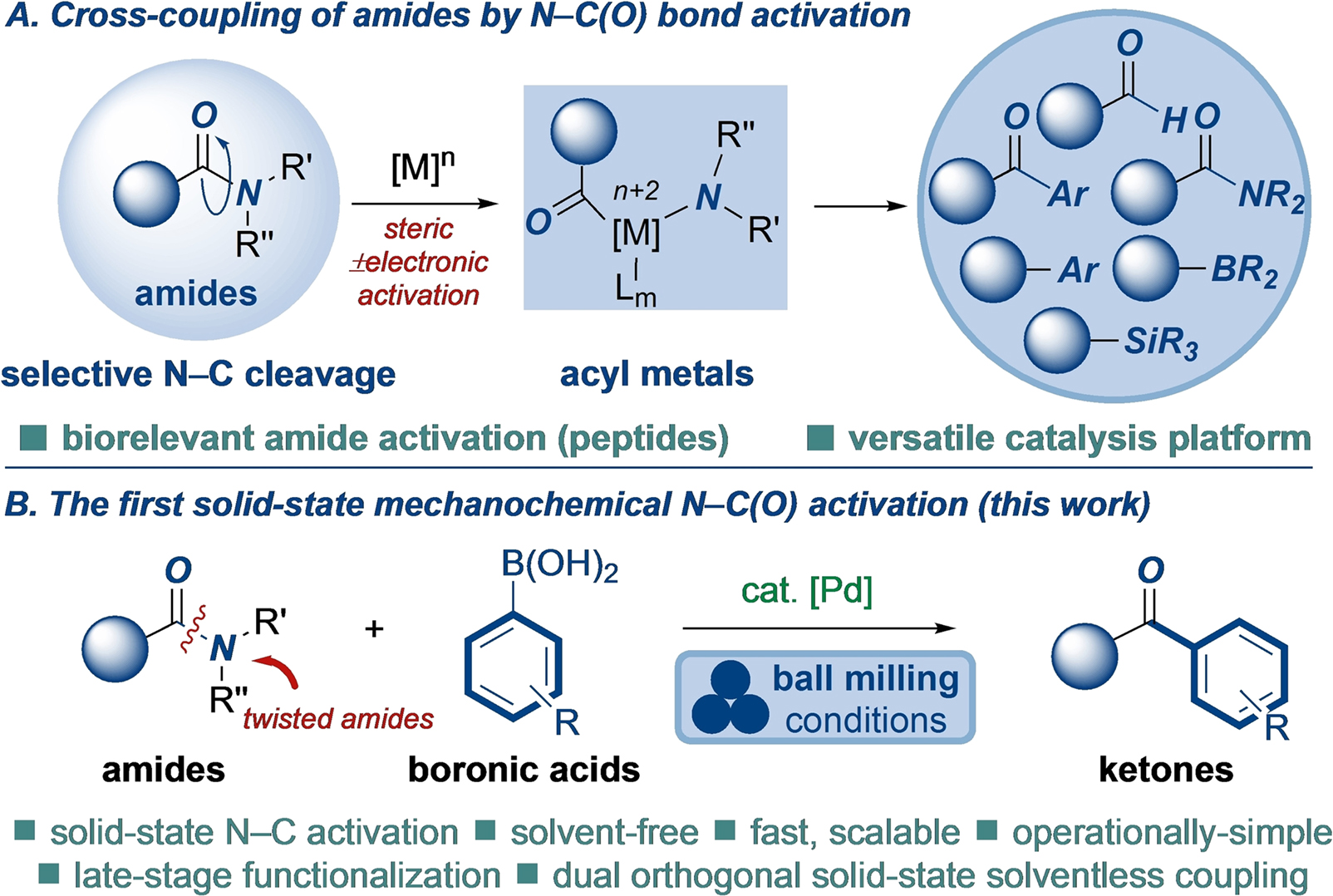
General manifold of amide bond activation (A) and the solid-state mechanochemical N–C(O) activation (B). Reprinted with permission from Ref. (Zhang et al., 2022). Copyright: (2022) John Wiley and Sons.

Application to the synthesis of pharmaceutical intermediates. Reprinted with permission from Ref. (Zhang et al., 2022). Copyright: (2022) John Wiley and Sons.
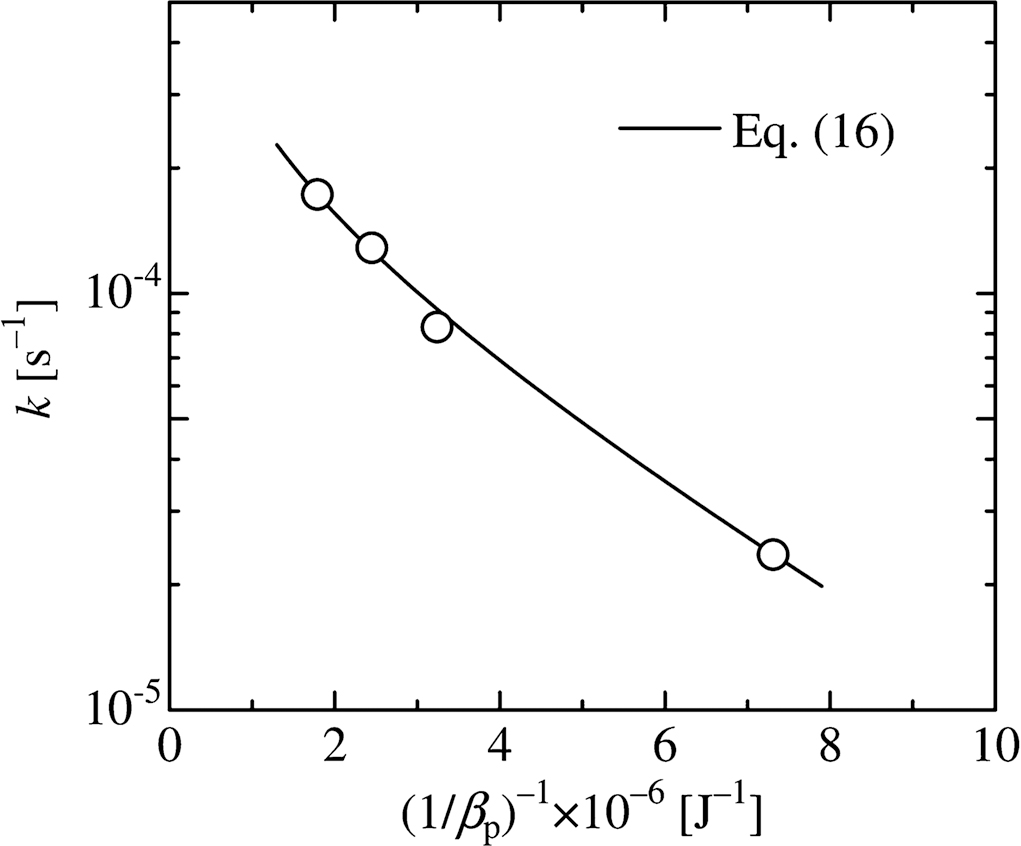
Relationship between the reaction rate constant and the reciprocal of a parameter representing the kinetic energy of particles. Reprinted with permission from Ref. (Hirosawa et al., 2019). Copyright: (2019) Elsevier.
Many researchers have actively challenged to dry mechanochemical synthesis of various high-performance particles from inorganic (Goga et al., 2021; Hlova et al., 2014; Muh’d et al., 2015; Pal et al., 2018; Wu et al., 2021), organic (Oh et al., 2020; Otsuka and Goto, 2022; Zhang et al., 2018) and organic–inorganic (El Ajjouri et al., 2019; Martínez-Sarti et al., 2020; Tanaka et al., 2013) materials, which will probably lead to the achievement of SDGs in future. For example, the development of functional fertilizers by dry mechanochemical syntheses (Alrbaihat et al., 2021; Barčauskaite et al., 2020; Borges et al., 2021; Tan et al., 2021; Zheng et al., 2021) can contribute widely to SDGs such as the goals 2, 8, 9, 12 and 15.
3.4 Mechanochemically assisted process for particle synthesisMechanochemical treatments have often been used to assist the progress of chemical reactions. Štrukil and Sajko (2017) developed a novel mechanochemical approach for solid-state visible light photocatalysis. The method is very simple; the photochemical reaction proceeds during milling at room temperature using a visible (blue)-light-irradiated vibration mill with a glass jar. They demonstrated that both the light irradiation and the mechanochemical treatment are required to effectively promote the solid-state photocatalytic reaction. The method contains some potential applications in the growing field of photoredox catalysis and supramolecular chemistry. Onizuka and Iwasaki (2022) developed a novel solvent-free process for synthesizing hematite nanoparticles under environmentally friendly conditions. This method contains the mechanochemical treatment of ferric nitrate nonahydrate as the iron source and urea as the precipitant, which releases the crystal water from the iron source to be used for the urea hydrolysis (Fig. 10). In addition, the mechanochemical effects promote the hematite formation during heating even at low temperatures. The particle size was changed by the amount of urea and the heating temperature (Fig. 11). The low-temperature solvent-free method using urea hydrolysis may also be applicable to the environmentally friendly synthesis of other metal oxide nanoparticles. As an effective technique, dry mechanochemical pretreatments for activating the precursor of chemical reaction by thermal treatments, such as heating (Çolak et al., 2017; Iwasaki et al., 2016; Suetsugu, 2014), calcination (Ashiri, 2016; Bulina et al., 2017; Hashimoto et al., 2020; Kosova and Semykina, 2019; Lejda et al., 2020; Liu et al., 2020; Qiu et al., 2021) and hydrothermal treatment (Kanie et al., 2018; Nada et al., 2019; Osuga et al., 2022; Zhang et al., 2020), have often been employed in the synthesis of various functional nanoparticles for weakening the thermal treatment conditions.
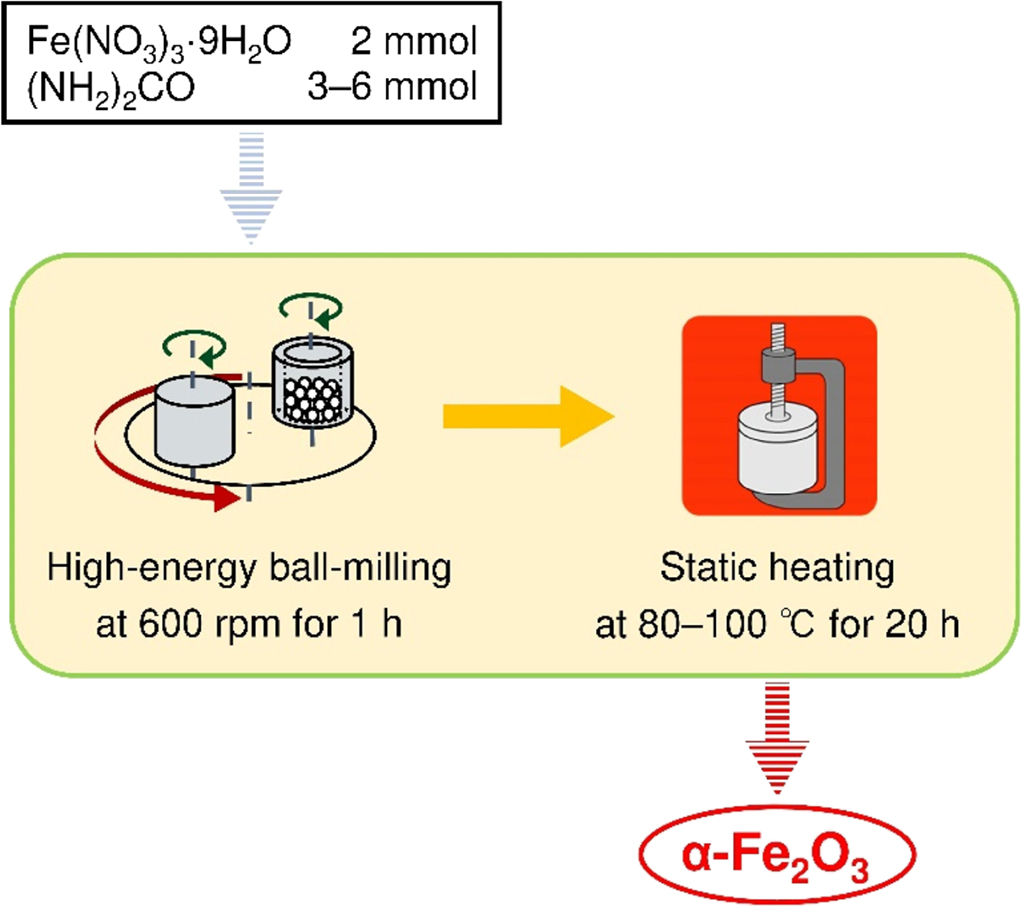
Mechanochemically assisted synthesis of hematite nanoparticles developed by Onizuka and Iwasaki (2022). Reprinted with permission from Ref. (Onizuka and Iwasaki, 2022). Copyright: (2022) Elsevier.

Crystallite sizes of hematite nanoparticles obtained with different amounts of urea at different heating temperatures. Reprinted with permission from Ref. (Onizuka and Iwasaki, 2022). Copyright: (2022) Elsevier.
Focusing on grinding and mechanochemical processes, this review presents the possibility of dry mechanical processes to the contribution of the achievement of the SDGs. In particular, from a viewpoint of the reduction of energy consumption and waste, dry mechanochemical processes may be suitable to an on-demand production of small quantity and large variety of high-performance fine particles in the consuming area. This may also lead to the contribution to the transition to a decarbonized society. For further enhancing the functionality and performance, the synthesis of nanosized particles cannot be avoided. However, nanoparticles have some concerns in health and environment. Thus, the nanoparticles should be used considering carefully the balance of valuables of nanoparticles and its contribution to the SDGs. Toward the realization of a sustainable society, various problems relating to fine particles, such as bioaccumulation of microplastics and nanoparticles discharged to environments, must be urgently solved. In addition, the automated system and labor saving is required for improvement of the work environment. Dry particle synthesis processes can play an important key role for the achievement of the SDGs. The author believes that the dry mechanical powder processes have the great potential to contribute directly or indirectly to all of the SDGs.
Tomohiro Iwasaki
Tomohiro Iwasaki is a Professor of Chemical Engineering at Osaka Metropolitan University in Japan. He received his master’s degree in Chemical Engineering from Osaka Prefecture University. He also received his Ph.D. degree in Chemical Engineering from Osaka Prefecture University. His research interests include mechanochemical processes, organic–inorganic hybrid materials (organoclays, layered organosilicates) synthesized via intercalation, ferrite nanoparticles for magnetic hyperthermia treatments, and discrete element simulation of ball mills.